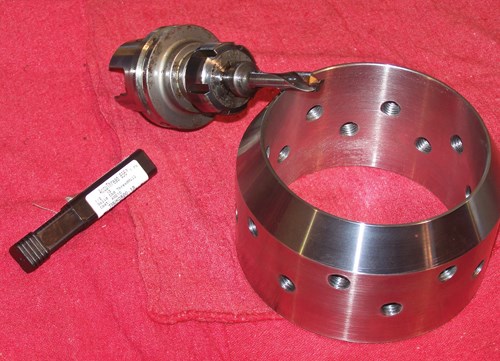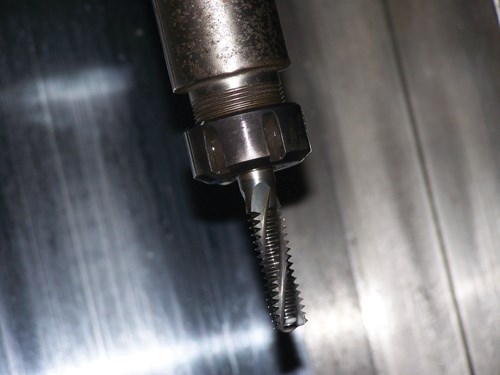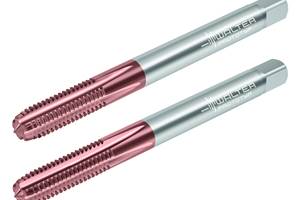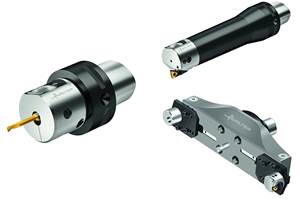When the phone started ringing one day last November at his machine shop in Pearland, Texas, Rickey Ray Ramirez had a pretty good idea of who was calling. His suspicions were soon confirmed. “Brad, it’s okay, it really doesn’t need to be changed,” he reassured the man on the other end of the line. “It’s still running, and the tip looks great.”
Brad Whiting, territory manager with cutting tool manufacturer Allied Machine & Engineering (Dover, Ohio), had been checking in every day to see how the Gen3sys XT high-penetration drill he’d recommended was faring. It had been almost a week, and Mr. Ramirez still hadn’t changed the carbide insert. When Mr. Whiting went back to the shop to see for himself, the drill was still humming along, just as Mr. Ramirez had reported. At his urging, Mr. Ramirez installed a fresh insert, just to be safe. By that point, the drill had completed more than 5,000 holes at 0.75 inch deep, about 10 times the amount that could be produced with the tool it replaced. The new drill was faster, too. In fact, changing the tool, adjusting cutting parameters accordingly and keeping all else constant reduced both cycle time per hole and cost per hole by approximately 90 percent, Mr. Ramirez says.
The part that prompted Mr. Ramirez to purchase the drill is a 4140 alloy steel stabilizing ring, a part used on oil rigs. That type of job is typical fare for his Houston-area precision job shop, R-Cubed Precision Machining (so named for his initials: R. R. R.). In fact, Mr. Ramirez estimates that 90 percent of his work is for petroleum industry components. Nonetheless, he says he’ll take on any project he can reasonably accommodate.
Mr. Ramirez founded the shop four years ago after deciding to leave a supervisory/managerial position at a major petroleum industry company and go into business for himself. With a large family and a 24-year background in the manufacturing industry, he has no shortage of friends and relatives who work as machinists or on local oil rigs. Sometimes they create opportunities for new customers and sources of work. That was the case with the stabilizing ring, he says. When a machinist cousin had trouble cutting the part cost-effectively with a manual mill, he thought Mr. Ramirez’s turn -mill machine, an Integrex 200Y from Mazak (Florence, Kentucky), might fare better.
He was right, with one exception. Sawing the barstock, turning the OD and boring the ID all proceeded smoothly. However, drilling each part’s 16 threaded holes became a bottleneck that slowed production on the entire job. The cobalt stub drills Mr. Ramirez chose for the application simply couldn’t penetrate the 0.75-inch-thick material fast enough.
With 1,500 parts to deliver and the potential for a repeat contract, this wasn’t a job Mr. Ramirez wanted to abandon. So he contacted Rick Jones at CW Rod Tool Co., a trusted local supplier, to seek a new tool for drilling the 0.4331-inch-diameter holes. Mr. Jones put him in touch with Mr. Whiting, who offered the Gen3sys XT on a guaranteed test order basis. That is, if the replaceable-insert drill provided the promised improvements at manufacturer-recommended parameters, Mr. Ramirez would buy it. However, if the tool didn’t perform to expectations—or worse, crashed—Mr. Ramirez wouldn’t be liable for anything.
As the latest high-penetration drilling system from Allied Machine & Engineering, the Gen3sys XT builds on advancements pioneered in the company’s previous Gen3sys line. Both systems use the same tool bodies, which are available in diameters ranging from 11 to 35 mm and in four different drill-to-depth lengths: stub, 3×D, 5×D and 7×D. The XT inserts feature cutting edge and corner enhancements that further improve penetration rates, chip control, durability and stability, the manufacturer says. It adds that the inserts’ AM300 coating provides sufficient heat and wear resistance to last as much as 20 percent longer compared to its previous AM200 coating.
XT inserts are available in four different geo-metries: a standard geometry, which is a versatile choice for steels and alloys; a low-rake configuration for poor machining conditions or especially hard materials; a geometry designed for cast iron applications; and a new geometry dedicated to machining austenitic stainless steels. With hardness ranging from 22 to 28 Rc, the 4140 alloy steel that constitutes Mr. Ramirez’s stabilizing rings is common in oil and gas industry applications, so Mr. Whiting recommended the standard XT geometry.
By the time Mr. Whiting arrived at R-Cubed Precision Machining to test the system, Mr. Ramirez had already produced about 100 of the parts. With the original cobalt stub drill, he had settled on a 1.76-ipm feed rate and a surface speed of 40 sfm. At that rate, he could produce one hole every 20.45 seconds, which wasn’t nearly fast enough to deliver the parts on time. After about 500 holes, the tool tended to break down. Cost per hole was 73 cents. “I had a well-established program and I knew it would work, so it was time to see if that drill could do what he claimed,” Mr. Ramirez says. “I was ready to invest in a quality tool, but I wanted to make sure I was getting my money’s worth.”
As it turned out, the Gen3sys XT paid for itself in the first run, Mr. Ramirez says. The men started the tool slow, but the final parameters far eclipsed those used for the previous drill. They stopped boosting the feed rate at 18.6 ipm, a 956.8-percent increase. Surface speed in-creased by 777.5 percent to 351 sfm. Drilling at that rate reduced cycle time and cost per hole to 1.94 seconds and 8 cents, respectively, amounting to a time savings of 90.5 percent and a cost savings of 88.76 percent. Cycle time per part decreased from 26 to 16 minutes.
In fact, Mr. Ramirez says he wanted to push the drill even further, but Mr. Whiting was reluctant to exceed the parameters recommended by the manufacturer. In keeping with this cautious approach, he stuck around to ensure drilling operations would continue to proceed as smoothly as they had thus far. “We couldn’t believe the results we were getting,” Mr. Ramirez recalls. “Brad was willing to wait and gradually see what happened, not just run three or four parts and say ‘bye’ only to have the tool crash on the fifth.”
Before leaving for a few days to tend to other customers, Mr. Whiting left an extra insert for Mr. Ramirez to use and told him to call if he needed additional inserts. That’s when the daily phone calls started. Every time Mr. Whiting checked in, Mr. Ramirez was still using the same insert at the new parameters. As it turned out, each Gen3sys XT insert could machine approximately 5,040 holes before beginning to wear, a 908-percent increase compared to the previous drill.
For R-Cubed Precision Machining, swapping tools paid dividends in addition to the time and cost savings gained on the initial run of 1,500 stabilizer rings. The next time the customer needed an order for the same part, it turned again to Mr. Ramirez’s shop. In fact, he says he’s been producing stabilizer rings all year. The tool has proved useful for other work as well, he says. “Any time I need to drill a hole with a 1/4-inch NPT thread, this is the drill I use.”















.png;maxWidth=300;quality=90)




.png;maxWidth=300;quality=90)












.png;maxWidth=970;quality=90)